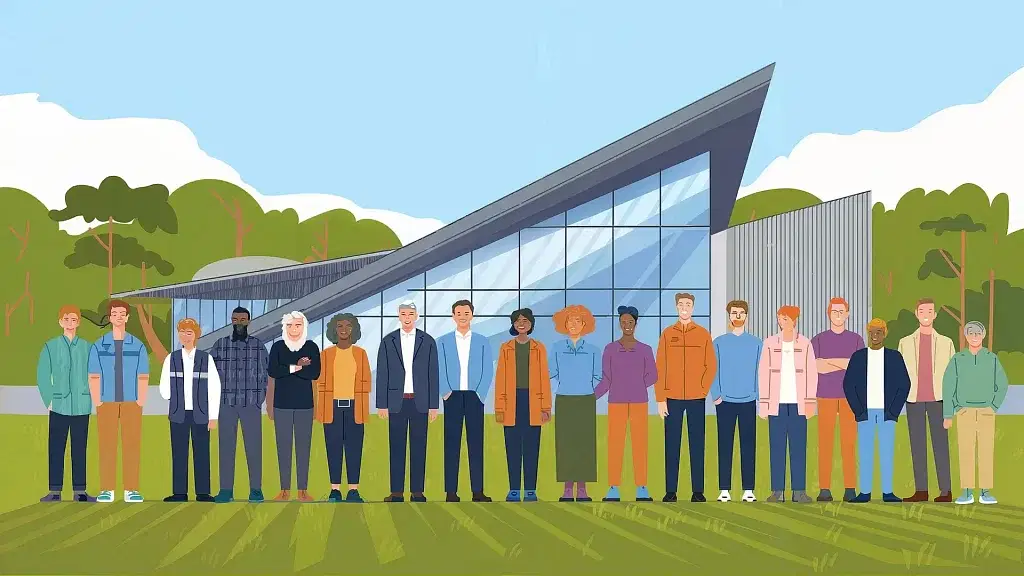The Art of HOA Architectural Reviews: Finding the Sweet Spot Between Property Rights and Community Standards
There’s nothing quite like the moment when a homeowner discovers they need permission to paint their own front door. “But it’s MY house!” they cry, forgetting that small print in their deed about community standards. Meanwhile, HOA board members wince at yet another application for what can only be described as the world’s brightest teal trim. Finding middle ground between personal expression and neighborhood harmony isn’t easy—but with 47 years of experience helping East Bay communities, SLPM Homeowners Association Management Services has seen it all and lived to tell the tale.
Why Architectural Standards Matter (Even When They Drive Us Crazy)
Let’s be honest—nobody buys a home dreaming about form submissions and committee approvals. Yet architectural standards protect what most homeowners truly want: stable property values and visually pleasing neighborhoods.
In the East Bay’s varied housing landscape, these standards matter even more. A 2024 UC Berkeley Urban Design Lab study found that 73% of homebuyers in Alameda and Contra Costa counties listed consistent neighborhood appearance as a deciding factor when purchasing. The California Association of Realtors backs this up with data showing neighborhoods with active architectural committees maintain property values 11-18% higher than areas without design oversight.
Those numbers translate to real dollars when you sell. The difference between “that neighborhood with the purple house and the front yard car collection” and “that well-maintained community near the park” shows up directly in your home’s market value.
The Legal Stuff: California’s Rules of the Road
California lawmakers have created specific guardrails for HOA architectural control. The Davis-Stirling Act requires associations to:
- Provide written decisions within 60 days after applications
- Explain reasons for any denials
- Offer appeals through board reconsideration
Recent updates to Civil Code Section 4765 also mandate annual distribution of architectural guidelines to all members. Miss this step, and your HOA might find its enforcement powers weakened when challenges arise.
East Bay communities face additional complexity with local regulations. Oakland’s Green Building Requirements and Alameda County’s Residential Design Standards affect decisions about solar panels, drought-tolerant landscaping, and accessibility modifications. When these local rules conflict with HOA preferences, California law usually sides with the higher authority.
Creating Guidelines That Work (Without Starting a Revolt)

Successful architectural policies walk the tightrope between too vague (“keep it nice”) and too strict (“Swiss coffee white paint only, no exceptions ever”). SLPM Homeowners Association Management Services recommends these core components for East Bay communities:
1. Clear Exterior Modification Standards
Material Guidelines: Specify acceptable roofing materials with safety in mind. Those cedar shakes might look charming, but in fire-prone areas like the Oakland Hills, they’re a hazard waiting to happen.
Color Boundaries: Create color palettes that make sense for your neighborhood’s style and climate. Homes in foggy Albany face different moisture issues than those in sunny Livermore.
Landscape Rules: Match water conservation standards with EBMUD regulations. This prevents the awkward situation where homeowners must choose between HOA fines or water district penalties.
2. Streamlined Review Processes
Realistic Timelines: Set 30-45 day review windows for standard applications. Longer waits create frustration; shorter windows don’t give volunteers enough time for thorough review.
Tiered Approval Systems: Not all changes need full board attention. Create a fast track for minor modifications like mailbox replacements or identical window swaps, saving full review for major projects like room additions.
3. Smart Compliance Approaches
Regular Inspection Schedules: Quarterly exterior reviews catch issues early before they become bigger problems.
Graduated Fine Structures: Start with friendly notices before jumping to penalties. Most homeowners respond well to information before fines enter the picture.
Detailed Records: Keep modification histories for each property. These prove valuable during resales and help resolve disputes about what was approved when.
East Bay Special Considerations (Because We’re Not Like Everyone Else)
Our unique geography and varied communities require tailored approaches:
Microclimates Matter
The Bay Area’s famous microclimates affect building materials and maintenance needs:
Fog Belt Properties: Homes in areas like San Leandro’s bay-facing neighborhoods deal with moisture that can quickly damage certain exterior finishes. Guidelines should acknowledge these challenges.
Hill Areas: Communities in Orinda and Moraga need special attention to fire-resistant materials and erosion control measures. Safety trumps aesthetic preferences here.
Historic Character Preservation
Some East Bay neighborhoods represent distinct architectural eras worth preserving:
Berkeley’s Elmwood District and Piedmont’s Grand Avenue area maintain supplemental guidelines for period-appropriate details like:
- Window trim profiles that match original designs
- Historically accurate porch styles
- Fence heights and designs consistent with neighborhood character
Accessory Dwelling Unit Realities
With California pushing for more affordable housing, East Bay HOAs must align with state ADU laws while addressing community concerns about:
- Parking impacts when units increase household density
- Height restrictions that protect neighbor privacy and views
- Minimum rental durations to prevent short-term rental problems
Real-World Success Stories (Yes, They Do Exist)
Solar Panel Harmony in Livermore
A 243-unit Livermore community faced a flood of solar installation requests in 2023. Rather than fighting the inevitable green energy transition, SLPM Homeowners Association Management Services helped implement:
- Pre-approved mounting system designs that simplified applications
- Screening requirements for ground-level arrays to maintain aesthetics
- Shared inverter station guidelines to reduce visual clutter
The result? Every single installation followed guidelines, with zero violations or legal challenges. Homeowners got their clean energy while the community maintained its visual standards.
Fence Peace Treaty in Fremont
Cultural preferences created tension in a diverse Fremont community. Some residents wanted six-foot privacy fences; others preferred open yard designs. After 22 violation notices in 2022 sparked heated meetings, SLPM Homeowners Association Management Services helped broker a compromise:
- Six-foot maximum height with three approved lattice top designs
- Options for vegetative privacy screens using approved plant lists
- Grandfather provisions for existing structures with five-year compliance windows
Follow-up surveys showed 94% satisfaction with the new standards. The key was recognizing legitimate differences in privacy expectations while creating consistency in materials and quality.
Running a Review Committee That Won’t Make Everyone Hate You
Effective architectural review requires the right people and processes:
Committee Makeup
- Include members with some construction or design background when possible
- Rotate volunteers annually to prevent burnout and bring fresh perspectives
- Provide Fair Housing Act training so decisions don’t accidentally discriminate
Digital Workflow Tools
- Online application portals save everyone time and create documentation trails
- GIS mapping helps visualize project impacts on surrounding properties
- Automated status updates prevent the dreaded “black hole” where applications disappear
Contractor Management
- Maintain lists of approved vendors who understand community standards
- Negotiate group discount rates for common projects like roof replacements
- Review contractor performance annually based on completed projects
When Things Go Sideways: Solving Architectural Disputes
Even the best systems face conflicts. When disagreements arise, try these approaches:
Mediation Steps
- Schedule joint meetings between homeowners and committee members
- Use visual simulations to show how proposed changes would look
- Bring in neutral third parties when emotions run high
Finding Alternatives
- Suggest comparable materials or designs that meet both personal and community goals
- Consider phased approvals for complex projects to ensure compliance at each stage
- Look for precedents in similar HOAs that solved similar problems
Legal Protection
- Document everything—every conversation, email, and decision
- Partner with attorneys who specialize in HOA law when serious disputes arise
- Review insurance coverage for architectural decision liability
Building Buy-In For Standards (Instead of Resentment)
Clear communication prevents the “architectural police” reputation:
Education Efforts
- Host yearly workshops explaining the “why” behind guidelines
- Create visual guides showing approved versus denied modifications
- Publish case studies in community newsletters to illustrate consistent decision-making
Homeowner Input Channels
- Provide digital feedback forms for proposed guideline changes
- Use anonymous surveys to evaluate policy satisfaction
- Create resident-led subcommittees to review guidelines periodically
How Professional Management Elevates Your Architectural Process
With 47 years in East Bay HOA management, SLPM Homeowners Association Management Services brings tested expertise:
Custom Guideline Development
We create frameworks matching your community’s unique character, not cookie-cutter rules from somewhere else.
Legal Compliance Reviews
Annual audits of your CC&Rs against current California law prevent costly legal challenges.
Committee Training
Interactive workshops prepare volunteers to make fair, consistent decisions.
Technology Integration
Our proprietary workflow systems track applications from submission through completion.
The Payoff: What Good Architectural Management Delivers
East Bay HOAs that implement clear guidelines, fair processes, and consistent enforcement see measurable benefits:
- Homes sell 22% faster than in neighborhoods without consistent standards
- Neighbor disputes over exterior modifications drop by 40%
- Resident satisfaction increases by 18% in annual surveys
Perhaps most importantly, well-managed architectural processes create communities where people want to live—places with character and quality that maintain their appeal over decades.
The Sweet Spot: Finding Balance in Your Community

The best architectural guidelines don’t try to create cookie-cutter neighborhoods where every house looks identical. They allow personal expression within frameworks that protect everyone’s investment and living experience.
Finding this balance isn’t simple—it requires local knowledge, legal expertise, and practical experience. That’s where SLPM Homeowners Association Management Services’s 47 years in the East Bay provides value. We’ve helped communities from Oakland to Livermore develop architectural guidelines that reflect their unique character while navigating California’s complex regulatory environment.
Your community deserves architectural standards that protect property values without creating unnecessary friction. Professional management can help you find that sweet spot where individual rights and community standards work together instead of colliding.
Take the next step toward more effective architectural management: Request a FREE Customized HOA Management Proposal
Sources:
Alameda County Residential Design Standards
San Francisco Planning Code
California Civil Code Section 4765


